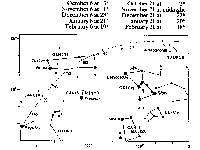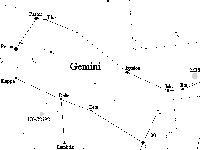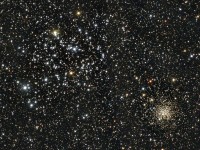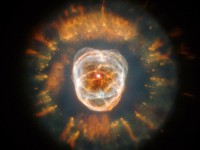Orwell Astronomical Society (Ipswich)
Gemini Observing Project, December 2003 - March 2004
Introduction
From late winter to early spring, the constellation Gemini is prominent throughout most of the night. The constellation culminates at midnight on 07 January and is conveniently placed for early evening observation from mid-December until early April. It covers an area of 514 square degrees and thus accounts for approximately 1.2% of the heavens, slightly greater than the average for a constellation (1.1%). In a clear sky, Gemini and the surrounding regions present a truly glorious vista: Canis Minor with the first magnitude star Procyon lies to the south; the magnificent Orion to the south-west; Taurus to the west; and Auriga to the north-west. The Milky Way runs through the western edge of Gemini, and the region contains many objects of interest to the amateur astronomer. Figure 1 shows Gemini and its neighbouring constellations.
Historical Perspective
Gemini is an ancient constellation. Ptolemy of Egypt catalogued information on Gemini in circa AD 140 in The Almagest, his comprehensive compilation of Greek astronomical knowledge. The leading stars of the cosntellation, Castor and Pollux, are separated by just 4.5° and form an unmistakable pair: mankind has believed since ancient times that they represent twins. In Greek legend, the twins were the sons of Leda and Zeus and were venerated by mariners and invoked for protection against storms and other perils of the sea. (The electrical glow sometimes seen above ship’s rigging, St Elmo’s fire, was referred to as the Ledaean Lights in classical times.) The Romans venerated Castor and Polux as the Dioscuri, the sons of Zeus, guardians of the city. Ancient Arabians called Castor & Pollux The Twins. In ancient India, Castor and Pollux were known as The Horsemen.
Stars In Gemini
Figure 2 shows the main stars in Gemini. The most prominent stars, Castor and Pollux, are both first magnitude objects, and together they mark the eastern edge of the main part of Gemini. The remainder of the constellation typically visible to the naked eye consists of
two lines of stars running west, together with some outliers. The most prominent stars are as follows:
- Castor, alpha Gem, the Northern Twin. The name means The Horseman. Castor is the finest multiple star in the northern sky (see below).
- Pollux, beta Gem, the Southern Twin. The name derives from the Greek Polluces, meaning The Boxer. Further details below.
- δ Gem, a magnitude 3.5 double star. Clyde Tombaugh, working at Flagstaff Observatory, discovered Pluto nearby on 18 February 1930, by a "blink" comparison of photographic plates exposed on 23 and 29 January.
- ζ Gem, one of the brightest Cepheid variables in the sky, with a magnitude range 4.4 - 5.2 and a period of 10.15 days. (Cepheids are employed as "standard candles" in astronomy through their period-magnitude relationship.) The star was discovered to be variable in 1847. In common with all Cepheid variables, the variability of ζ Gem is associated with pulsations in the body of the star caused by tension between radiation/gas pressure and gravity in the outer layers of the star. Changes in the opacity of an ionisation layer near the surface of the star (the layer is more opaque when compressed) provide the mechanism to maintain the oscillation and prevent the star settling into equilibrium. ζ Gem has a luminosity some 5700 times that of the Sun.
- η Gem, a red giant, magnitude 3.3, slightly variable, with a luminosity 160 times that of the Sun. There is a close secondary component at magnitude 6.5. The primary is itself a spectroscopic binary: there is a minor eclipse every 8.2 years. All three components are enveloped in a gas cloud some 300 AU in diameter. William Herschel discovered Uranus near η Gem on 13 March 1781 with 6.2 inch reflector during his second sky survey.
- 1 Gem, which marks the approximate location of the Sun at summer solstice.
- ε Gem, a magnitude 3.0 supergiant G-type star, like a very much larger version of the Sun. The star has a luminosity 5700 times that of the Sun (like ζ Gem).
Gemini contains several variable stars in addition to ζ Gem – see [1] for details.
 Fig. 1. Sky vista around Gemini.
Fig. 1. Sky vista around Gemini.
 Fig. 2. Stars in Gemini.
Fig. 2. Stars in Gemini.
Castor And Pollux
Castor and Pollux, the leading stars of Gemini, form an unmistakable pair. Their chief characteristics are as follows:
Castor: magnitude 1.6, distance 45 light years. The Sun would shine at magnitude 6 at the distance of Castor - visible on a clear night to the naked eye if only if one knew exactly where to look for it! Castor is the most impressive multiple star in the northern hemisphere: it comprises six components. The main pair, Castor A and Castor B, orbit one another at a distance of 12 billion km (more than the diameter of the Solar System), with a period of approximately 400 years. A third component, Castor C, orbits the A/B pair at a distance of 160 billion km, some 15 times the diameter of Solar System, with a period of some 10,000 years. Spectroscopic analysis shows each of the A, B, C components to be itself double. The A1 and A2 components of A are identical, each with a diameter of 3 million km and 12 times solar luminosity. They orbit one another at a mean separation of 6.5 million km with an orbital period of 9.2 days. The B1 and B2 components of B are also identical to one another, each with a diameter of 2.2 million km and 6 times solar luminosity. They orbit one another at a mean separation of 5.0 million km with an orbital period of 2.9 days. The C1 and C2 components of C are two similar red dwarfs, with diameters 1.0 million and 1.1 million km. Each shines with a luminosity only 2.5% that of the Sun, and they orbit one another at a mean separation of 2.5 million km with an orbital period of 19.5 hours.
The main A, B, C components are easily visible in a small telescope. The magnitudes are respectively 1.9, 2.9 and 9.1. The A, B components were widest (apastron) in 1880 at 6.5 arcsec, closest (periastron) in 1968 at 1.8 arcsec and are currently separated by 4.0 arcsec, a separation which is easily resolved in a small telescope. The C component is approximately 1.2 arcmin distant from the A/B components.
G D Cassini in 1678 was first to resolve the A/B components of Castor. J Bradley in March 1718 re-discovered the multiplicity of the star. Astronomers noted the change in PA of the A/B components between 1719 and 1759: this led Sir William Herschel to conclude in 1803 that the components formed a system in which the stars are gravitationally linked. Castor was therefore the first physical binary to be identified as such, and the first object beyond our Solar System in which the force of gravity was shown to operate.
Pollux: magnitude 1.2, distance 35 light years, approximately four times the diameter of the Sun and 35 times as bright. The Sun would appear as mag 5 star at the distance of Pollux. Note that Pollux lies close to the distance of standard magnitude (10 parsec) so its apparent and absolute magnitudes are similar. Pollux, although designated Beta Geminorum, is in fact slightly brighter than Castor, designated Alpha Geminorum. There are several faint stars close to Pollux, but none are gravitationally bound to it.
There is a pronounced colour difference between Castor and Pollux, clearly visible to the naked eye or in a simple time-exposure photograph: Castor is a white/bluish colour, while Pollux has a golden/orange hue.
Double And Multiple Stars
Gemini contains a variety of double and multiple stars which provide varying degrees of challenge to the amateur observer. Table 1 lists the main details. The stars are listed in order of increasing difficulty, and the Tomline Refractor is suitable to separate them all with the exception of Eta Gem, which is a challenge for a 300 mm instrument.
μ Gem
3.2, 9.4
122
Wide separation. Visible in binoculars.
ζ Gem
3.8, 10.5, 8.0
87, 96
Wide separation. Visible in binoculars.
ε Gem
3.0, 9.0
110
Wide separation. Visible in binoculars.
20 Gem
6.3, 6.9
20
Yellowish & bluish components – very pretty!
38 Gem
4.7, 7.7
5.2
White and white/yellow components.
Castor
1.9, 2.9, 9.1
3.9, 70
Visible in a small telescope.
κ Gem
3.6, 8.1
7.1
Slightly easier than δ Gem.
δ Gem
3.5, 8.2
5.8
Easier than λ Gem, since magnitudes more nearly the same.
λ Gem
3.6, 10.7
9.6
Test for a 75 mm telescope, with large difference in magnitudes.
η Gem
3.3, 8.0
1.6
Primary is variable. Companion discovered in 1881.
Table 1. Double and Multiple Stars In Gemini.
Deep Sky Objects
The Milky Way runs through the west of Gemini and, as a result, the constellation contains a rich set of galactic clusters. However, the star clusters and deep sky objects in Gemini are in general difficult to observe from locations near Ipswich, with the exception of M35
and NGC2392. The problem is largely one of light pollution creating a background skyglow which offers poor contrast for faint, extended objects. The main deep sky objects accessible to the visual observer are as follows.
- M35: a glorious galactic cluster, integrated magnitude 5.3, located 2.5° NW of Eta Gem. It has a visual diameter of 30 arcmin (similar to the full moon). It is visible to the naked eye on the clearest nights – I have seen it once with the naked eye from Ipswich (using averted vision to find it initially but then able to use direct vision once its precise location was known). Messier included M35 in his catalogue in 1764, but he did not discover the object – it was known earlier, e.g. John Bevis showed it in his star catalogue in 1750. M35 is circa 2500 light years distant and has a diameter of circa 30 light years. Lord Rosse (of Birr Castle, Ireland) counted 300 stars in M35 in the nineteenth century. However, he appeared to include some field stars, and a modern estimate for the number of stars in M35 is circa 150. The brightest star in the cluster is magnitude 7.5 and is 400 times as luminous as the Sun. (The Sun at the distance of M35 would shine at magnitude 14 – only just visible in the Tomline Refractor!) M35 is easily visible in binoculars or a small telescope. Larger telescopes, up to circa 200-300 mm instruments, give ever better views. Telescopes larger than about 300 mm generally do not provide a field of view which enables the observer to appreciate the cluster in its entirety. M35 has something of a void at its centre, from which long streamers of stars lead out in all directions. Figure 3 (below), an image of M35 from the Hubble Space Telescope, shows well the central void and streamers.
- NGC2158: a discrete star cluster apparently entangled in the outer western streamers of M35. NGC2158 has an integrated magnitude of 11; it is visible in a 150 mm telescope as a faint blob, some 4 arcmin in diameter. NGC2158 contains circa 150 stars, the brightest shining at magnitude 16. It is circa 15,000 light years distant, lying on the outer rim of the galaxy. It would be a magnificent object if at same distance as M35. (The Sun at the distance of NGC2158 would shine at a feeble magnitude 18, i.e. one of the faintest members of the cluster!) Figure 3 shows NGC2158 at the bottom right of the image.
- NGC2392: a small, bright planetary nebula lying midway between Kappa and Lambda Gem, discovered by William Herschel in 1787. It lies approximately 3000 light years distant and has a diameter of 0.6 light years. It appears as a magnitude 9.2 object circa 15 arcsec in diameter. NGC2392 shows good contrast against the background sky, and will stand a high magnification. A small telescope will show a bright disk (magnitude 8) standing out well against the background sky while a very large telescope will show detail within the nebula. The appearance of the object in large telescopes and some long-exposure photographs suggests the appearance of a face wrapped in a hood, so the object is sometimes referred to as the "Clown Face Nebula" or "Eskimo Nebula". Note that a planetary nebula is nothing to do with a planet! Rather, it represents a late stage of evolution of a star of up to eight solar masses. The star develops into a giant star with a cool surface (could be as cool as 1000 K or less) that is generally somewhat unstable and ejects mass. Mass ejection can continue until the remaining core star has a mass of only about 0.6 solar masses. The ejected gas is ionised by radiation from the compact, burnt-out stellar core at its centre – the radiation stimulates light emission, producing the so called planetary nebula. Planetary nebulae generally last for up to 50,000 years before fading and dispersing into the interstellar medium. The archetypal planetary nebula is M57, the "Ring Nebula" in Lyra. The central star of NGC2392 is a magnitude 10 object, approximately 40 times the luminosity of the Sun. Its surface temperature is 40,000 K. Figure 4 is an image of NGC2392 captured by the Hubble Space Telescope in January 2000. Analysis of it and similar photographs shows that material in the nebula is receding from the core star at 100 km/sec.
 Fig. 3. M35 & NGC2158.
Fig. 3. M35 & NGC2158.
 Fig. 4. NGC2392.
Fig. 4. NGC2392.
Gemini also contains several fainter star clusters and planetary nebula, of which the most accessible are listed below. Consult [1] for positions and other details.
- NGC2420: a cluster containing some 30 stars in the magnitude range 10-18 in a region of diameter 5 arcmin.
- NGC2129: a cluster containing some 50 stars, magnitudes 8-15 in a region of diameter 5 arcmin, concentrated towards the centre. I counted 20 stars in this cluster on 24 Jan 2004.
- NGC2266: a cluster containing some 75 stars of magnitude 11-15 in a region of diameter 5 arcmin.
- IC443: a very faint supernova remnant; not visible to the naked eye, needs a
long exposure photograph.
- NGC2371/2: an hourglass-shaped planetary nebula. Magnitude 12.5.
Other Features Of Gemini
Gemini has several other key features, as follows.
- Geminid meteors: the Geminid radiant lies very close to Rho Gem. The Geminids are visible 07-15 December, with maximum on 13 December. ZHR 80. The shower has been fairly constant over the last century. The parent body is minor planet 3200, rather than a comet – so the meteor shower is relatively consistent. The Geminid meteors are medium speed, bright and leave few trains. A report in the OASI Newsletter details a spectacular Geminid storm on the evening of 13 December 1980. Six OASI observers witnessed the storm outside the Levington Ship from 21:00 UT to 01.30 UT. They counted 281 meteors, equating to a rate considerably in excess of one per minute (allowing for breaks in the observing schedule (perhaps associated with the proximity of The Ship?) There were two spectacular fireballs estimated at magnitude –5.
- The ecliptic passes through Gemini, so the planets and Moon are occasionally visible in the constellation. Saturn is currently (early 2004) in Gemini, brighter than any of the stars. An occultation by Mars of Epsilon Gem occurred on 07 April 1976 – several UK observers reported a flickering of the starlight just before occultation, presumably due to the Martian atmosphere. There are no reports of members of OASI observing this event.
Gemini Observing Project
Gemini presents a magnificent spectacle and offers numerous interesting objects for the amateur to observe. I proposed an observing project in the February 2004 OASI Newsletter to encourage members of OASI to make observations of the constellation, and asked observers to forward their results for collation. The project was linked with the Astronomy Workshop on 04 February 2004 and the Small Telescopes Observing Nights (STON) on 16 February and 01 March 2004. I asked observers to provide details of their observations as follows:
- Naked eye observations: basic outline of constellation; comparison of Castor and Pollux and comparison of them with Saturn (currently in the constellation); attempt to find M35 visually.
- Observing with binoculars: M35; NGC2392; widely spaced double stars Mu, Zeta and Epsilon Gem.
- Observing with a telescope: M35; NGC2392; close double stars 20, 38, Alpha (Castor), Delta and Lambda Gem.
A total of 11 members of OASI participated in the project and returned their observations. Table 2 provides details.
James Appleton
28 Dec 2003 & 24 Jan 2004
Naked eye, 10x50 binoculars and 254 mm Meade LX200 SCT
Alice Longhurst
22 Feb 2004
Naked eye and 10x50 binoculars
Neil Morley
09 Feb 2004 (STON)
Naked eye, 10x50 binoculars and 250 mm Dobsonian
Mike Nicholls
24 Jan 2004
Naked eye, 10x50 binoculars and 200 mm reflector
Paddy O’Sullivan
06 Feb & 09 Feb 2004 (STON)
Naked eye, 114 mm reflector and 250 mm Dobsonian
Pete Richards
?
Naked eye, 10x50 binoculars and 90 mm Meade ETX-90 Maksutov-Cassegrain
Dave Robinson
25 Feb 2004
Naked eye and 10x50 binoculars
Ted Sampson
25 Feb & 01 Mar 2004 (STON)
Naked eye and 125 mm Meade ETX-125 Maksutov-Cassegrain
Roy Tremlett
25 Feb 2004
Naked eye and 8x30 binoculars
Harold Watters
29 Feb 2004
Naked eye, 12x40 binoculars and 90 mm Meade ETX-90 Maksutov-Cassegrain
Paul Whiting
15 Feb 2004
Naked eye and 7x50 binoculars
Table 2. Observers.
The observers spanned a range of ages and experience. All made their observations in and around Ipswich, with the exception of Paul Whiting, who observed from Tiverton in Devon. (Paul thereby maintained his record of observation made furthest from Ipswich, which he claimed for the 2002 Pleiades Observing Project, when he filed observations from Woomera, South Australia!) Several observers collaborated at Orwell Park Observatory during the STON on 09 February and 01 March. At the first STON, Neil Morley, Paddy O’Sullivan and Gerry Pilling joined forces, while at the second, seven members of OASI joined Ted Sampson to observe. The observers at the STONs agreed that observing in a group in this way was much more rewarding than observing alone!
The observers had to face the usual problems encountered by British astronomers, primarily light pollution and uncertain weather. Unfortunately, the weather during February was not kind and it was not until the end of the month that many observers were able to make observations. By this time, the Moon was in Gemini, making observation of deep sky objects in the constellation very difficult.
Naked Eye Observations
All eleven observers reported naked eye observations. The were easily able to discern the outline of the constellation. Ten observers reported a pronounced colour difference between Castor and Pollux while one reported no discernible difference. Comments on the colour difference were as follows:
- Slight difference.
- Castor blue/white; Pollux orange.
- Castor bluish; Pollux yellowish.
- Castor slightly bluer and fainter; Pollux slightly orange.
- Castor bluish; Pollux orange tinge.
- Castor pale white/creamy; Pollux sandstone, brighter than Castor.
- Pollux slightly yellow/orange.
- Pollux slightly brighter than Castor. Pollux slightly orange, not as deep orange as Aldebaran or Betelgeuse. Castor white.
- No difference: both Castor and Pollux look white.
Ten observers reported a discernible difference in magnitude between Saturn and Castor/Pollux. Observers’ reports were as follows:
- Saturn much brighter than Castor/Pollux.
- Saturn twice as bright as Castor; Pollux half-way in between.
- Saturn brighter than Castor/Pollux and slightly yellowish.
- Saturn brighter than Pollux; Pollux in turn brighter than Castor. Saturn yellowish.
- Castor and Pollux similar in magnitude; Saturn a lot brighter.
- Saturn far more pronouncedly orange than Castor/Pollux.
- Saturn brighter than Pollux; Pollux in turn brighter than Castor. Saturn yellow.
- Saturn brighter than Castor/Pollux and tan/yellow.
- Saturn brighter than Pollux; Pollux in turn brighter than Castor. Saturn and Pollux a similar orange colour.
- Saturn much brighter than Castor/Pollux. Saturn yellowish, comparable to Capella.
Three naked eye observers reported seeing M35 for certain. One of the three reported needing averted vision to see the object. Another reported using averted vision to find the object, but once found being able to view it with direct vision. A fourth observer reported an uncertain observation of M35.
Binocular Observations
Ten observers reported observations with binoculars (mostly 10x50, but also 8x30, 12x40 and 7x50). Eight observers reported finding M35 in binoculars, while one reported being unable to locate the object due to interference from moonlight. Binocular observers reported the following comments on M35:
- An unexciting smear.
- A fuzzy blob.
- A misty patch.
- Large (possibly circa 30 arcmin diameter), faint object with slight hint of granularity.
- Visible (I think) with averted vision. Possibly triangular in shape.
- Hazy triangular shape.
- A fuzzy, featureless blob.
Only two observers were able to find NGC2392 with binoculars. They reported the following comments:
- A small, faint (difficult) object, definitely identified afterwards from "Sky Atlas 2000".
- Very faint, hazy, no structure visible.
Six binocular observers reported being able to locate the wide double stars Mu, Zeta and Epsilon Gem; however only one observer was able to split the doubles, reporting this as quite easy.
Six binocular observers reported sweeping through the dense star fields at the western edge of Gemini. They reported the following comments:
- Many stars visible.
- Much greater density of stars then in the rest of Gemini.
- Spectacular – full of stars!
- Milky Way as spectacular as ever.
- Rich star fields evident despite strong moonlight.
- Very rich, patchy bright clumps of stars.
Another three observers reported strong moonlight and/or light pollution preventing them from making effective observations of the western edge of Gemini.
Telescopic Observations
Six observers reported observations with telescopes. Five telescopic observers reported observations of M35. Their comments were as
follows:
- Open cluster.
- Open cluster with a number of strings of stars.
- Star cluster.
- Saw only a section of it in the eyepiece (Tomline Refractor and 250 mm Dobsonian) – beautiful sight.
- Central void plus streamers visible – spectacular! NGC2158 very difficult to find, visible at the edge of M35.
The planetary nebula NGC2392 is a more difficult object than M35, and only one observer reported positively being able to find it, with one other observer reporting an uncertain observation. The observers’ comments were as follows:
- I think that I found it - just a streak of nebulosity.
- Central star of NGC2392 clearly visible as a sharp point, surrounded by two rings of nebulosity – the inner ring brighter than the outer.
Three observers commented on moonlight interfering with their attempts to find NGC2392.
One telescopic observer reported splitting the wide double stars Mu, Zeta and Epsilon Gem.
Five telescopic observers reported finding and splitting some or all of the close double stars 20, 38, Alpha (Castor), Delta and Lambda Gem. Two of the five observers reported successfully observing all five close double stars. Three of the five observers reported being able to split Castor into its components, although one of the three was able to split only the wide components (A/B from C) but not the much closer components (A from B). Three of the five observers were able to split Lambda Gem, but reported that this was difficult because of the large difference in the magnitudes of its components.
Acknowledgement
Thanks are due to all observers who supported the project.
Reference
Robert Burnham, Jr., "Burnham’s Celestial Handbook", Dover Publications, Inc., 1978.
James Appleton